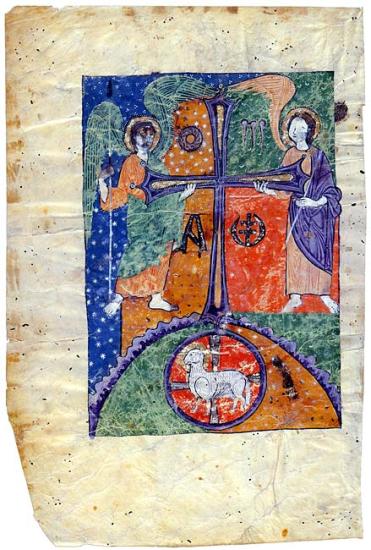
Victorious Cross Of Oviedo
Beatus of Liébana
Las Huelgas Apocalypse
Purchased by Pierpont Morgan, 1910
Many Beatus manuscripts begin with a full-page Cross of Oviedo, so named after Greek-shaped crosses in the treasury of Oviedo Cathedral that were thought to imitate the cross carried by Pelayo of Asturias in his 722 victory over the Moors at the battle of Covadonga. (Pelayo's battle was regarded as the beginning of the Christian Reconquista.) Here, however, the political symbolism of the cross has become blended with that of the Passion. Angels hold a Latin cross, spear, and sponge. More instruments of the Passion, the crown of thorns and the three nails, float above, while the Greek letters, alpha and omega, unattached to the arms of the cross, hover below. The Greek cross does appear with the Lamb in the roundel at the bottom.
PREFATORY CYCLE
Maius, who about 945 illuminated the earliest complete Beatus is credited with the idea of adding a cycle of Christological miniatures before the Apocalypse section. Here the cycle begins with the Oviedo Cross and Christ in Majesty, followed by eight pages devoted to the evangelists and their symbols. Then comes a long genealogy of Christ, beginning with Adam and Eve. In the final miniature St. Michael triumphs over Satan.
The artist responsible for these eighteen miniatures has been named the Master of the Prefatory Pages. He is thought to have been active in Toledo because of similarities found with miniatures in a copy of St. Ildefonsus's Treatise on the Virginity of Mary, now in Madrid (cod. 21546). Ildefonsus (d. 667) was the archbishop of Toledo.
The Apocalypse, or Book of Revelation, is not only the last Book of the New Testament, but its most difficult, puzzling, and terrifying. It provided challenges to medieval illustrators and was the source for a number of popular images, such as Christ in Majesty, the Adoration of the Lamb, and the Madonna of the Apocalypse and contributed to the widespread use of the Evangelists' symbols.
Selected images from Apocalypse Then: Medieval Illuminations from the Morgan, an exhibition held at the Morgan are presented here. The exhibition celebrates the completion of a facsimile of the Morgan's Las Huelgas Apocalypse—the latest dated (1220) and largest surviving manuscript of a Spanish tradition of illuminated commentaries on the Apocalypse by the monk Beatus of Liébana. The series of manuscripts constitutes Spain's most important contribution to medieval manuscript illumination.
The Las Huelgas Apocalypse contains three sections: the prefatory cycle, the Apocalypse, and the Book of Daniel.
In addition to forty-nine images from the Las Huelgas Apocalypse, six images from other manuscripts in the Morgan's collections, including the earliest Beatus painted by Maius and one by the Master of the Berry Apocalypse, are in this presentation.
